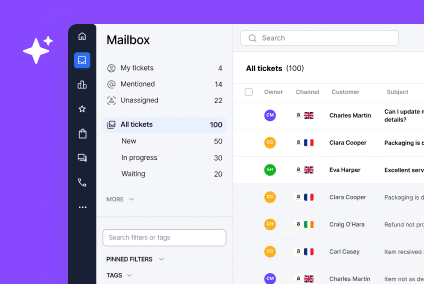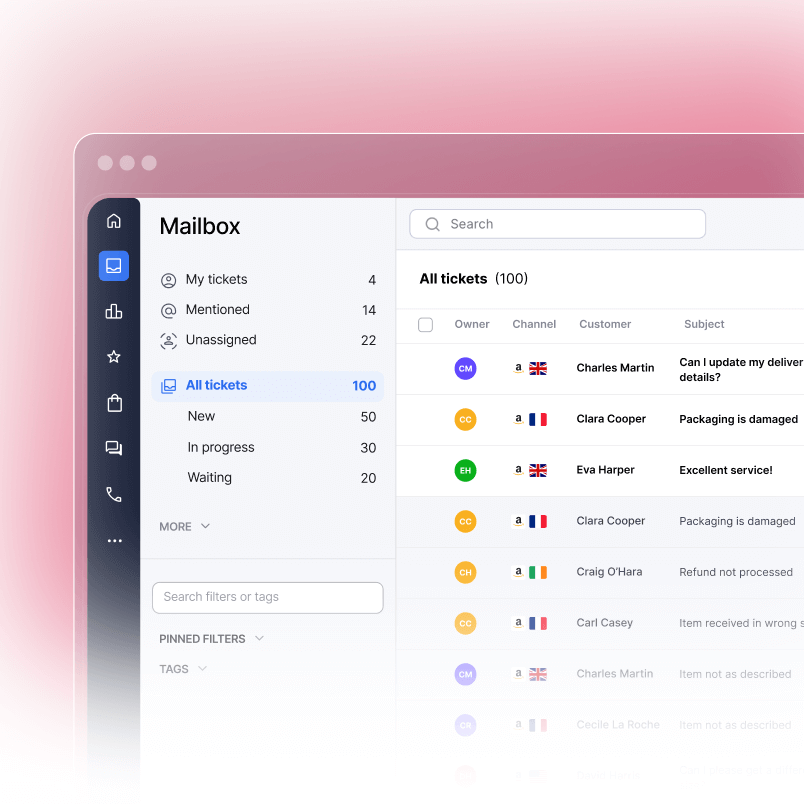Customer service managers have always required expertise and the ability to remain flexible in the face of change. In 2025, it’s even more so. The customer journey has become increasingly omnichannel – merging web, mobile, and in-store – for a more dynamic experience. In fact, customer expectations around all aspects of the shopping experience are rising, even amongst a backdrop of global supply chain hiccups.
The bar is set high for customer service managers in the coming year, who have their work cut out for them, ensuring that their customers’ needs are being met and that their teams are delivering excellent customer service at all touchpoints.
In addition to managing customers’ needs, customer service managers must also manage their team of customer service representatives internally, providing training and mentoring while ensuring they stay on top of all the latest customer service trends and technologies. It’s not a job for those without ambition!
In 2025, customer service is set to take center stage as an even more significant part of the business growth strategy. In fact, 64% of customer and support leaders say that ‘business growth’ will be the critical priority for customer service in 2025. Increasing value for customers through positive, proactive customer service interactions will be a key part of generating broader business growth.
It’s clear that delivering a strong customer experience is increasingly a key factor in business, and the role of customer service leaders is becoming more and more important – and multi-faceted – as we move into the new year.
Understandably, the job of a customer service manager requires much finesse and know-how, and 2025 is the year that customer service professionals can step up to the plate to measurably drive business in a big way.
The Art of Customer Service Management
The role of the customer service manager is a careful balancing act, not without its challenges. On its face, the role requires the obvious – that’s the need to deliver effective customer service. This is the cornerstone of the role, as a solid customer service strategy boosts a company’s reputation in the market and is instrumental in helping drive new business and increase customer retention and loyalty. Retention, in particular, is essential since studies show that, on average, 65% of a company’s business comes from its existing customers.
But when we look beneath the surface at what it means to be an effective customer service manager, it becomes clear that there is a lot of work taking place behind the scenes to strategically plan the processes that make customer support run smoothly; this is truly where customer service managers shine.
From training customer service teams to devising and implementing more efficient ways of managing customer tickets, customer service managers have their work cut out for them. The multi-layered role requires strategic forward planning; successful customer service managers are proactive rather than reactive.
A big part of being proactive and strategic means keeping one’s finger on the pulse of the industry and new technologies driving customer service. Effective customer service managers must have a view of new customer trends and channels and be able to incorporate these into their overall customer service strategy. In addition, customer service managers must also be aware of new software and tools available that can increase call center efficiency and decrease overheads.
The role of a customer service manager is one that requires business acumen, strategic thinking, and the ability to think on the fly and pivot when needed.
Omnichannel Customer Service Managers
When devising best practices for customer service managers in 2025, it’s important to note the role of omnichannel solutions within customer service. According to research from Google, omnichannel strategies now drive an 80% higher rate of incremental store visits. This means that businesses must not only ensure their services are offered to consumers across numerous channels, but that the customer service is as well.
While the phone remains the most popular method of contacting customer support, today there are several ways in which customers can reach an agent or an automated service for help. Offering omnichannel customer service channels means incorporating social media, online forms, customer portals (typically geared for self-service), messenger apps, and online/live chat support (which can be powered by artificial intelligence) into the customer service toolkit.
The emergence of customer service across multiple channels means that customer service managers must develop and maintain streamlined control to ensure the smooth running of customer support through all these channels, ensuring that nothing is missed and that efficiency is maximized.
It’s certainly a big ask, but ambitious customer service managers know that employing a few best-practice solutions can go a long way towards ensuring the success of their entire customer service operation across all channels.
Tips for Customer Service Managers in 2025
Now that we’ve reviewed the landscape that customer service professionals are operating within this year, here are our top tips that customer service managers can take on board to improve their company’s customer service offering in 2025.
1. Take a Proactive Approach
Proactivity plays an important role in the job of a customer service manager. To be proactive entails taking inventory of the current customer service program and looking at ways it can be future-proofed and improved. Customer service managers can start by auditing their existing customer service processes to see where there’s room for improvement or where there’s space to try a different approach.
This starts by locating customer service process documents and matching them up against the systems in place. The items to evaluate include:
- Whether the customer service processes are truly reflective of the customer service being offered by the team.
- Whether customer service pain points have been correctly identified so that they can be addressed appropriately.
- Whether the customer service technologies employed are the right ones needed for the particular business type and its unique customer service issues.
- Whether there are any untapped applications of the current customer service technology in place – is the customer service team making the most of the software available to them – or is there another product on the market that might help them be more efficient?
Next, customer service managers should review the KPIs (Key Performance Indicators) set for the department and determine whether they are achievable or whether it’s time to set new goals for the year ahead.
By honestly reviewing the company’s processes and standing KPIs, managers are better able to understand the weak points of their customer service strategy and can act on the areas that require improvement.
2. Seize Control of Social Media
Social media usage is abundant and ever-present! In fact, research shows that 45% of the world’s population uses social media and 54% of customers prefer social media for customer service over the phone or email.
Most businesses today already incorporate social media into their customer support options, both because it’s been shown that handling customer service requests via social media channels is up to 12 times cheaper than handling the same requests by phone and because churn rates can increase by 15% when companies don’t respond on social media.
So, it’s important that each company have all social media covered by offering support across many platforms, including Facebook, Twitter, Instagram, Snapchat and YouTube. The process for dealing with inquiries via social media also needs to be streamlined for customer service to remain efficient.
In addition to reviewing existing systems, businesses should also look at social media customer service software and helpdesk tools available on the market. Having the right tools will ensure a more streamlined approach to customer service that creates ease for both customers and service professionals alike.
With the right toolkit, customer service managers can revamp and streamline their approach to social customer service by leveraging sentiment trackers, scheduling options, sentiment analysis and helpdesk ticketing automation. All of these can save precious time and ensure that customer support teams are empowered with the support that lets them do the job of helping customers as efficiently as possible.
3. Enable Fluidity Between Channels
As mentioned, customer service today is omnichannel, meaning it’s made up of various channels – including email, phone, social media, and automated chat – that all come together into one helpdesk solution. To be processed efficiently, it’s critical that all these different channels go through a centralized process.
By integrating and sharing information across all channels, customer service teams can generate a better picture of each customer, enabling them to provide more tailored customer support to each client.
The latest customer service software tools on the market help achieve this ‘full picture’ view of the customers. They offer sophisticated, intuitive, and user-friendly solutions that give customer service representatives the right tools at their fingertips to direct customers through a seamless chain to provide better assistance.
As omnichannel shopping and customer service alike ramp up, 2025 is the perfect year for customer service managers to evaluate available tools to see which might be able to help them centralize their customer support and create a more seamless solution across channels.
Doing so will benefit the whole of the business in the long run, as 80% of consumers say they are more likely to purchase a brand that provides a personalized experience. Once again, this is proof of the important business value that customer service plays in overall company success and profitability.
4. Empower Customer Self-Service
In addition to the customer service channels discussed above, one important (yet often overlooked) channel is customer self-service.
In most cases, customer self-service is offered in the form of a portal on your website where customers can find the answers to their questions or get troubleshooting information to solve their own problems. It can include a ticket area, a knowledge base, and a community forum so that customers don’t always have to depend on your team to find all the solutions they need.
This can help cut down on the volume of inquiries the customer service team receives while allowing customers to solve their own problems quickly.
Customer self-service can also be viewed as another form of value-add support. It doesn’t take the place of other direct support, such as contact with a live customer service representative, but does help enhance it.
Self-service offerings can help take the pressure off the customer service team, freeing up their time and maximizing their productivity, assisting those with more complex issues that cannot be solved through a self-service portal.
5. Offer Live Chat
Live chat is another form of customer service that is on the rise. According to recent research, about 85% of businesses are expected to opt for live chat support by this year.
Live chat is helpful in that it offers customers help with their issues in real-time, simply by visiting the business’s website. A chatbot powered by artificial intelligence (AI) is programmed to be able to respond with answers to frequently asked questions, similar to an FAQ.
Not unlike other forms of customer self-service, chatbots can help customers quickly find answers to common issues in a matter of seconds. Live chat isn’t always AI-powered, however. Sometimes it’s also operated by live customer service representatives who are online and helping resolve tickets in real-time.
Live people can handle more complex issues than chatbots, so it may be beneficial to employ live reps where possible and implement chatbots outside of business hours. They can automatically create helpdesk tickets if they can’t solve a customer’s problem using their limited capabilities.
AI technology is constantly evolving and there are powerful chatbot technologies on the market today that can go a long way towards resolving your customers’ issues while also sending the message that a business is ‘always open’ for support.
6. Gather Customer Feedback with Surveys
Customer surveys can be a powerful way to ensure that customer needs are continuously being met to a high standard by the customer service team. They can also identify areas where the customer service team may require additional training to improve satisfaction.
Customer surveys should be implemented in an unbiased way, for example, once the customer’s issue has been resolved and put to rest, asking questions using neutral language.
Surveys allow customers’ voices to be heard, so not only will customers feel that they are being listened to, but customer service managers will also get unbiased feedback on the issues that are critical to their overall business.
Automating surveys facilitates the gathering of a large pool of data from which customer service leaders can make more informed decisions around how to improve or reward their teams.
7. Expertise Starts with Product Knowledge
An often-overlooked component of providing excellent customer service is having a strong knowledge of the product being supported. As a foundational element of customer service, it is key that customer service representatives understand the ins and outs of the product. After all, how can customer service teams be expected to solve problems if they don’t fully understand the products themselves?
It can also reflect poorly on a company if its representatives don’t understand the product and cannot provide helpful advice. On the flip side, customers respond positively to representatives who understand the product well and provide valuable information and insights into solving problems.
To scale up the product knowledge base across teams, customer service managers should consider having their teams try the product out themselves. Hands-on experience can be invaluable, as when people experience the product, they can gain a deeper understanding of it on a practical level.
But if that’s not possible, resources such as online forums, customer feedback, internal sales records, and competitor information can be beneficial in understanding each product.
8. Step Up the Hiring Agenda for 2025
The best internal ambassadors within a company have a passion for its culture and products. Of course, all managers want to hire the best customer service representatives, and qualified professionals make the top of the CV pile!
Yet, when looking at qualifications on CVs, managers should not underestimate the importance of a person’s genuine passion for both your company and customer service as a whole. Someone can always be trained on procedures and software, but it’s much harder to train an employee to be passionate.
Managers can restructure hiring to become more subjective in 2025; for example, if they meet a candidate with both passion for customer service and the company and its products, it’s worth giving them a serious look, even if they don’t have as much previous experience. A candidate that is passionate about customer service is likely to become a valued team member.
9. Incentivize Team Members
In the customer service industry, it is often said that customers are a company’s best advocates, but it’s also important to remember that employees are too!
Happy, motivated employees are more likely not only to perform well but are also more likely to speak positively about their company or brand to friends and family.
With a trend towards workers shifting jobs in 2022, managers now have a broader pool to draw talent from and can use incentives to make strategic hires for the business. In addition to providing competitive salaries and benefits, managers can incentivize employees with gift cards or cash bonuses for exceptional performance. Performance-based incentives can be very motivating and give employees something positive to work towards.
Managers can also offer other, less-obvious incentives such as additional holiday days based on performance. Such non-monetary incentives often provide strong motivation for employees to go above and beyond.
Regardless of the type of incentives used, it is important that, at the very least, all competent managers should show recognition of superior performance and excellence on the job.
Simply rewarding employees with appreciation and encouraging words lets them know that they are valued and appreciated. And that can go a long way towards building a healthy, productive, and happy customer service team.
Final Thoughts
The world is shifting in dynamic ways – seemingly from day to day. Although these rapid changes add an extra layer of unpredictability and the need to roll with the punches, being a customer service manager is a dynamic and rewarding career. With 2025 still in its beginning stages, there’s no time like the present for managers to take control and revamp their customer service strategy for the year ahead. In offering these helpful guidelines, we hope it becomes your most successful year yet.
Book a demo to learn more about how eDesk can help your eCommerce business today. Ready to get started now? Try eDesk free for 14 days, no credit card needed.





